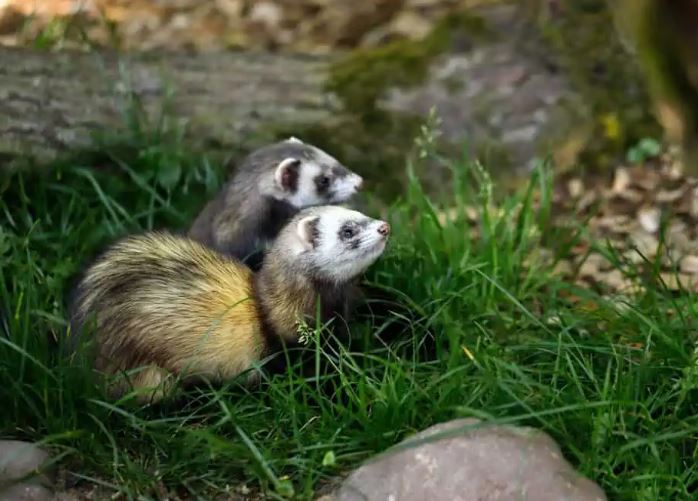


 3:44:51
3:44:51  2023-09-10
2023-09-10  1313
1313

Black-footed ferrets are North America's only native ferret species. They once ranged across the western plains but were thought to be extinct until a small population was discovered in 1981. Thanks to breeding and reintroduction programs, including the work of the Smithsonian Conservation Biology Institute, black-footed ferrets have made an incredible recovery!
Physical Description
Black-footed ferrets' color and markings blend well with grassland soils and plants, making them well adapted to their prairie environment. They are slender, wiry animals with a black facemask, black feet and a black-tipped tail. The rest of their body is short and sleek, with fur that is a yellow-buff color, lighter on the belly and nearly white on the forehead, muzzle and throat. Their legs are short with large front paws and claws developed for digging. Black footed ferrets' large ears and eyes suggest that they have acute hearing and sight, but smell is probably their most important sense for hunting prey underground in the dark.
Size
They are about the size of a mink—18 to 24 inches (46 to 61 centimeters) long, including a 5 to 6 inch (13 to 15 centimeters) tail. They weigh 1.5 to 2.5 pounds (around 1 kilograms) with males being slightly larger than females.
Native Habitat
Black-footed ferrets once ranged throughout the North American Great Plains wherever prairie dog colonies thrived, from southern Canada to northern Mexico. Today, they have been reintroduced into parts of their former range in Wyoming, South Dakota, Montana and Arizona.
Communication
Black-footed ferrets are very vocal. A loud chatter is used as an alarm call. A hiss is used to show agitation or fear, and females use whimpering sounds to encourage the young to follow. Male ferrets often "chortle" to females during breeding.
Food/Eating Habits
Ferrets have a high metabolic rate and require large quantities of food in proportion to their body size. Food requirements vary with the seasons and among individual ferrets, but they generally consume one prairie dog every three or four days.
In the wild, 90 percent of black-footed ferrets' diet is prairie dogs. One ferret may eat over 100 prairie dogs in a year, and scientists calculate that one ferret family needs more than 250 prairie dogs each year. The remainder of their diet includes mice, rats, ground squirrels, rabbits, birds and occasionally reptiles and insects.
The Smithsonian's National Zoo's black-footed ferret is fed a commercial carnivore meat mix, mice, and rats.
Social Structure
Black-footed ferrets lead solitary lives, except during the breeding season or when females are caring for young.
Reproduction and Development
Breeding activity generally occurs in March and April; after a gestation period of 41 to 43 days, a litter of kits is born. The average litter size is three to four young, but single kits, as well as litters of nine or ten, have been recorded. Only the female cares for the young. The kits are born blind and helpless, weighing only 0.2 to 0.3 ounces (5 to 9 gram) at birth, with thin, white hair covering their bodies. Their dark markings appear at about 3 weeks of age and young kits begin to open their eyes about 35 days after birth. Black-footed ferret kits develop very rapidly and become increasingly active after their eyes open.
Kits are about three-quarters grown by July when they first venture above ground. Long after they stop nursing, they depend on their mother for meals of meat. By late summer, the female leaves her kits in separate burrows during the day and gathers them together at night to hunt. Eventually, the young begin to hunt alone, and by September are usually independent and solitary. Ferrets become sexually mature at 1 year of age, and their peak reproductive period is at about 3 to 4 years.
Sleep Habits
Black-footed ferrets are primarily nocturnal. They spend most of their time underground in prairie dog burrows, typically spending only a few minutes above ground each day during the first few hours following sunrise to hunt or find new burrows or mates.
In burrows, they sleep, catch their food, escape from predators and harsh weather, and give birth to their young. Ferrets do not hibernate, but in winter, the amount of time they are active and the distances they travel decrease substantially. They have been found to remain underground in the same burrow system for a week at a time in winter. Males are more active than females: males tend to travel about double the distance that females do.
Lifespan
Few black-footed ferrets live beyond 3-4 years of age in the wild. They typically live to be about 4 years old in human care.
Reality Of Islam |
|

If you'

Imagine bei

MIT en
 9:3:43
9:3:43
 2018-11-05
2018-11-05
10 benefits of Marriage in Islam
 7:5:22
7:5:22
 2019-04-08
2019-04-08
benefits of reciting surat yunus, hud &
 9:45:7
9:45:7
 2018-12-24
2018-12-24
advantages & disadvantages of divorce
 11:35:12
11:35:12
 2018-06-10
2018-06-10
 6:0:51
6:0:51
 2018-10-16
2018-10-16
 11:34:48
11:34:48
 2022-06-29
2022-06-29
 8:3:0
8:3:0
 2018-06-21
2018-06-21
 12:10:56
12:10:56
 2022-11-17
2022-11-17
 3:18:29
3:18:29
 2022-12-24
2022-12-24
 10:47:11
10:47:11
 2022-11-22
2022-11-22
 10:43:56
10:43:56
 2022-06-22
2022-06-22
 2:5:14
2:5:14
 2023-01-28
2023-01-28
 5:41:46
5:41:46
 2023-03-18
2023-03-18
| LATEST |